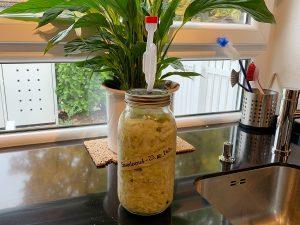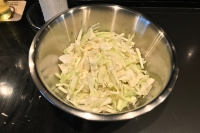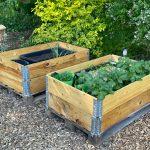Update october 2020: New sauerkraut, substantially more information added 🙂
Since I happen to be a “Kraut” by birth, I decided to home-make my own Sauerkraut. Fermentation using wild lactobacillus is an ages-old and easy way of preserving almost every reasonably hard/crunchy vegetable (read more here and here) you like. It’s easy and for our grandparent’s generation it was a perfectly common thing to do.
So what is this “fermentation thing” all about? In short: Fermentation is latin and means the decomposing of carbohydrates in foods by various bacteria or yeasts with no oxygen around. Besides improving digestability, this produces a wide variety of distinct aromatics and other substances, the most important one being acid (lactic acid in this case). Harmful bacteria cannot thrive in an oxygen-free, acidic environment, thus, our food becomes preserved.
Ingredients:
- 1 kg of white cabbage
- 20 g of salt (rule of thumb: 2% – ratio, that means 20g salt to 1 kg cabbage)
- optional: 1 tbsp. caraway, 1 tbsp. whole black peppercorns, 2 bayleaves, 1 tsp. juniper berries
Directions:
Remove the stem from the cabbage and shred it finely. The finer you chop it, the better. Mix all your ingredients and the cabbage in a large bowl (you will make a mess!) and knead gently. Then let sit for about 30-40 minutes to let some liquid build up at the bottom of the bowl.
Fill the mass into a large glass jar and add the collected water. Pound the mix down making sure everything is submerged in liquid. If not: Add some 2% – salt water (2g per 100 ml). Best place an intact leaf of cabbage on the top. It is crucial that everything is covered by liquid, thus, locking out any oxygen.
If you have one, attach a fermentation lock (which I highliest recommend! See the picture.) It will let pressure out of the jar, while at the same time prohibiting oxygen to get inside. Close the jar and store it in your kitchen at room-temperature place for about 5-7 days to get the fermentation going nicely. If you don’t have a fermentation lock, check from time to time and release some pressure if necessary. If you find mold building up, something went wrong and you’ll to throw it away unfortunately.
After 5-7 days, move the “Kraut” to a dark and cool place to prevent it from getting too sour, the fridge is ideal. The fermentation process will continue there, though much slowed down. After another 2-3 weeks, it’s time to taste-test your Kraut, it should be done by now. The Kraut will easily keep in the fridge for several months.




